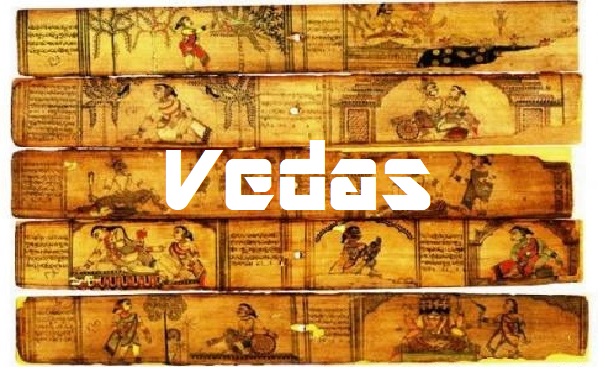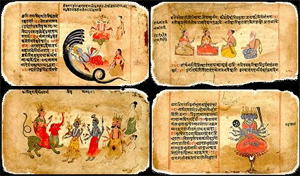Vedas – Rig Veda | Yajur Veda | Sam Veda | Atharv Veda

Vedas (वेद) is a collection of earliest literary record of India-Aryan civilization. The word Veda is derived from the word ‘Vid‘ that means ‘to know‘, written in India between 1500 and 1000 BCE.
Vedas are considered as the most sacred and oldest scripts of Hinduism in India. They are the revealed scriptures because they are considered to be divine in origin, they represent the original source of all knowledge and of religion.
“Universal Law” is revealed in the Vedas, the knowledge that Vedas give is endless. For example, the occurrence of six seasons, actions of sun, moon, the process of death, birth, worship, yoga philosophy, atomic energy, agriculture, knowledge of politics, administration, architecture, solar energy, business rules, about men, women, children, marriage, education, clothes, Brahmacharya, etc. every knowledge in there in Vedas.
Also Read: Vedic Culture / Hinduism
The Vedas share their place along with the Upanishads and the two great Hindu epics, the Mahabharata and the Ramayana as being among the most important documents of Hindu literature. Each Veda contains several sections and thousands of hymns.
Vedas are Sruti meaning ‘which is heard‘, something that was heard by rishis during there deep meditation. They are revelations of ancient rishis, which are mantric in a style where each verse contains specific meaning.
According to Vedas dharma, artha, kama, and moksha are the four goals of life. The word dharma has many meanings and one of them is the purpose of Purusha’s incarnation on a material level.
Artha has a general meaning for material resources acquired for fulfilling dharma and (optionally) kama and moksha.
The Kama means desire (based on attraction) to experience enjoyment.
Moksha means liberation from the bondage of material manifestation and has a different meaning in different yogic and philosophical traditions. Each mystic school claims that its methods lead to final liberation, while others lead only to inferior levels or realizations.
“Vedas are never created or destroyed. They merely get illuminated and de-illuminated but remain in God” Adi Shankrachary. Vedas are not books, they are the knowledge that originated in the hearts of Rishis.
The four Vedas
The Rig Veda, the Sam Veda, the Yajur Veda, and the Atharv Veda, the Rig Veda being the main.

Each Veda is subdivided into:
Mantra or Samhita part, this being a collection of hymns used in yajna or sacrifice. Brahmanas part, where the procedures, meanings, and commentaries of the mantra are detailed.
-
Rig Veda
Rig Veda’s (most ancient of all Vedas) gives knowledge of Almighty, its main theme is basic knowledge covering a wide range of topics as concepts, qualities, and characteristics of God, soul, and Prakriti (the primary source of nature). It also covers the properties of the visible and invisible world, and some basic aspects of physical sciences as chemistry, physics, mathematics, astronomy, cosmology, etc. It also contains human ideals and principles to be adopted in all walks of life. In words of Sayana, Rig Veda contains nature, properties, and activities of all types of materials, i.e., physical, metaphysics, and spiritual.
Rig Veda is the largest Veda in terms of language content. It has 10 Mandals; 1028 Suktas; and 10581 Rik Mantras. In the last century, many books have been published on Rigved including the Mool (main Sanskrit text), Bhashya (translations), Teeka (commentary), and Vyakhya (descriptions) on the whole or part of the Veda.
-
Yajur Veda
Yajur Veda gives knowledge of Karmas, it mainly deals with the mode of conduct, human psychology, activity and ways and means for infinite improvement in order to achieve the highest goal of life (Moksha). It is divided into two parts, the white Yajur, and the black Yajur. It emphasizes how to convert knowledge gained into useful activities and impart the same to other human beings.
Yajur Veda is the second of the four Vedas It has 40 Adhyayas and 1975 Yaju Mantras (Kandikayein). Unlike Rig Veda, Yajur Veda is more prodo-poetry which is called ‘kandikayein‘.
-
Sam Veda
Sam Veda tells about worship, it mainly deals with that knowledge and activity by which the soul of the human being is relieved from the cycle of life and death. It is devoted to the adoration, praise, and worship of God; manifestations of his powers; and mode of worship for spiritual attainments. Its devotional hymns engulfed with sublime thoughts, attained with emotional touch leave the human mind and soul in tranquility. It emphasizes human beings to develop their mental and spiritual powers to their highest order.
Sam Veda is the third Veda and the shortest in terms of the count of the Mantras. It has two shirshaks viz., Purvachik and Uttarachik, and has 1874 Mantras in total.
-
Atharv Veda
Atharv Ved is about medicines and God. According to Nirukta (11.18) “That by which all sorts of doubts and imperfections are removed; and expertise is achieved, is Arthava Veda“. The knowledge, activity, and practice lead to the state of perfection in all branches of knowledge, whether social or physical sciences. So Atharva Veda deals with science, technology, applied social sciences, and human behavior. Its subjects include mathematics, Physics, Chemistry, Astrology, Cosmology, Medical Sciences, Agriculture, Engineering, Military Sciences, Aeronautics, Creation of Universe, Political Science, Sociology, Psychology, Economics, etc but it does not include history.
Atharva is one of the highly misinterpreted Vedic Granth. Many of the knowledgeable people (including Saayan, Griffith, etc) has misinterpreted it to be of the Veda of Magic/Voodoism. There is nothing in the Vedas, including Atharva Veda that is opposed to the sciences and logic and Atharv Ved does not constitute Magic / Voodoism. Atharva Veda is in fact an encyclopedia of many sciences including the medical and chemical sciences.
Atharv Ved is the last of the four Vedas. It is also known by the names BrahmVeda (owing to its description on oneness of God), ChhandoVeda (being the giver of Aanand), and Atharvaangirash Veda (as it was acquired by Rishi Angiraa). It has 20 Kandas, 111 Anuvaak, 731 Sukta, and 5977 Mantras.






